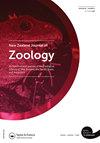A new genus for a large, endemic orb-weaving spider (Araneae, Araneidae) from New Zealand
IF 1.1
4区 生物学
Q3 ZOOLOGY
引用次数: 4
Abstract
ABSTRACT A new monotypic orb-weaving spider (Araneidae Clerck, 1757) genus, Courtaraneus gen. nov., is described to accommodate the New Zealand species C. orientalis (Urquhart, 1887) comb. nov. This new genus is proposed, as the male pedipalp of the species is unique amongst orb-weaving spiders by the presence of two complex tibial apophyses and a heavily sclerotised cymbial lobe at the base of a strong, elongated paracymbium. The pedipalp bulb is complex with heavily sclerotised sclerites. The median apophysis is situated transverse, the radix strong and wedge-shaped and the terminal apophysis heavily sclerotised and flat, U-shaped. The embolus is accompanied by three terminal apophyses on the elongated stipes. The female epigyne scape forms a tongue, surrounded by an elevated rim, the spermathecae are spherical. The unique autapomorphic characters of the new genus make the phylogenetical placement of the genus difficult. Courtaraneus orientalis comb. nov. is one of the largest endemic orb-weaving spiders in New Zealand and has been found in multiple locations in the North Island in scrub and forest margins. The orb-web is vertical, large, and the catching threads are widely spaced; however, the hub is poorly structured and the orb often incomplete.新西兰一种大型、特有的圆织蜘蛛的新属(蜘蛛目,蜘蛛科)
摘要描述了一个新的单型圆织蛛属(Araneidae Clerck,1757),Courtaraneus gen.nov.,以适应新西兰物种东方蛛(Urquhart,1887)的梳形。nov.提出了这个新属,因为该物种的雄性足须在球体编织蜘蛛中是独一无二的,因为它有两个复杂的胫骨突和一个坚固细长的副钹基部的严重硬化的钹叶。足须球复杂,有严重硬化的巩膜炎。中突位于横向,基部坚固且呈楔形,顶突严重硬化且平坦,呈U形。栓子在细长的托叶上伴有三个末端隆起。女性表观形成一个舌头,周围有一个凸起的边缘,受精囊是球形的。新属独特的自形态特征使该属的系统发育定位变得困难。东方Courtaraneus orientalis comb。nov.是新西兰最大的地方性球织蜘蛛之一,在北岛灌木丛和森林边缘的多个地方都有发现。球形网是垂直的、大的,并且捕捉线间隔很宽;然而,轮毂结构较差,球体往往不完整。
本文章由计算机程序翻译,如有差异,请以英文原文为准。
求助全文
约1分钟内获得全文
求助全文
来源期刊
CiteScore
2.80
自引率
0.00%
发文量
20
审稿时长
>12 weeks
期刊介绍:
Aims: The diversity of the fauna of the southern continents and oceans is of worldwide interest to researchers in universities, museums, and other centres. The New Zealand Journal of Zoology plays an important role in disseminating information on field-based, experimental, and theoretical research on the zoology of the region.

 求助内容:
求助内容: 应助结果提醒方式:
应助结果提醒方式:


